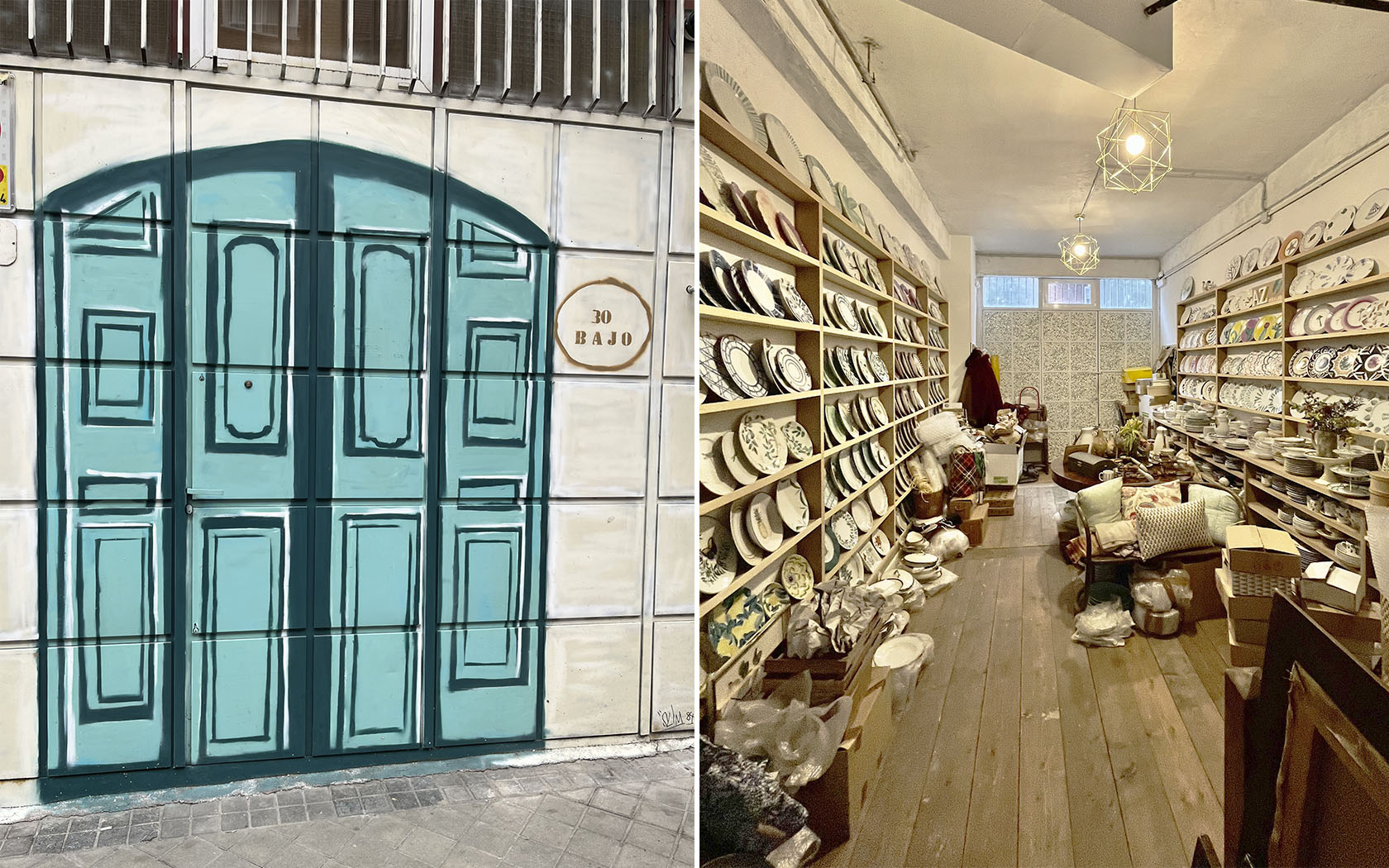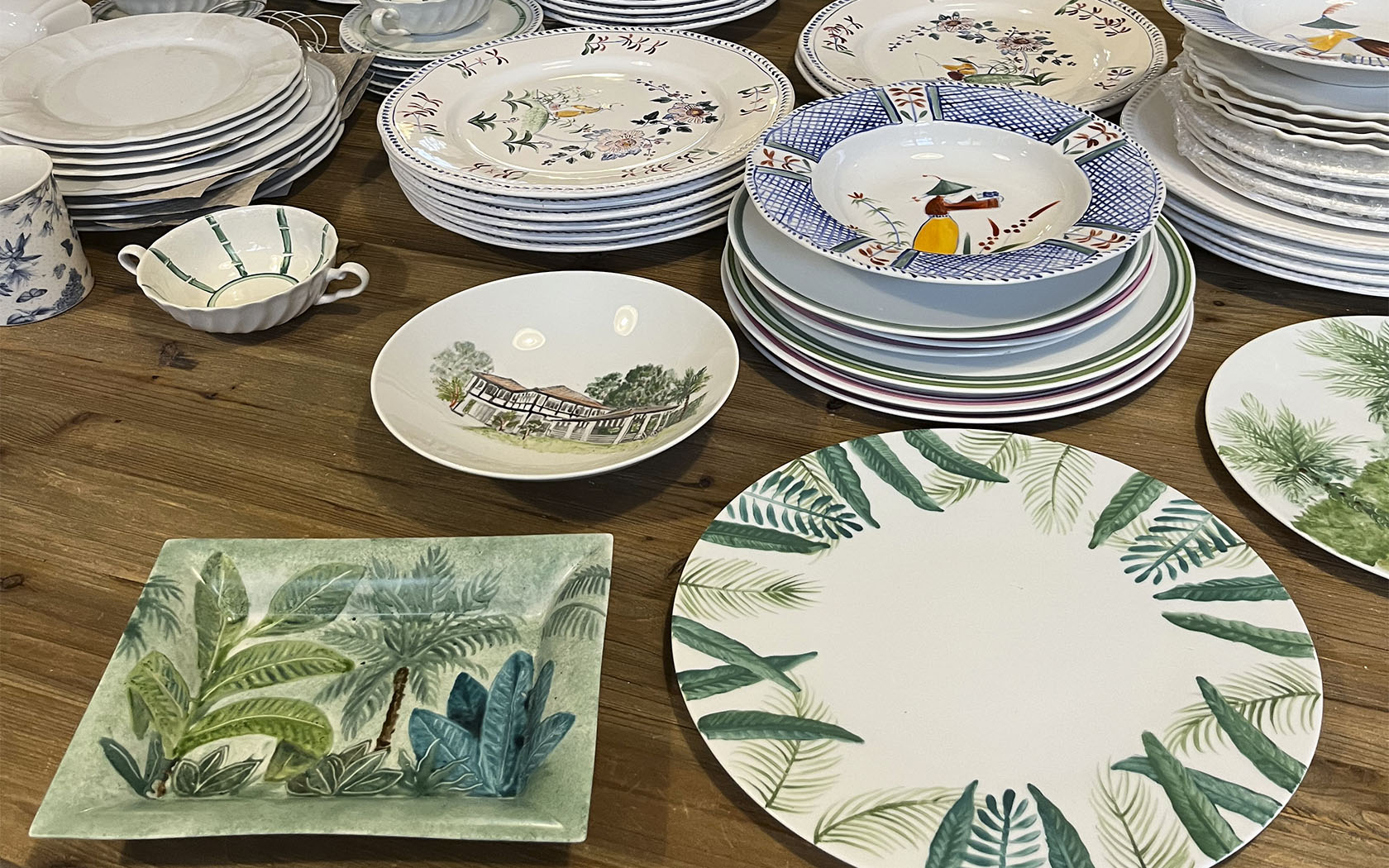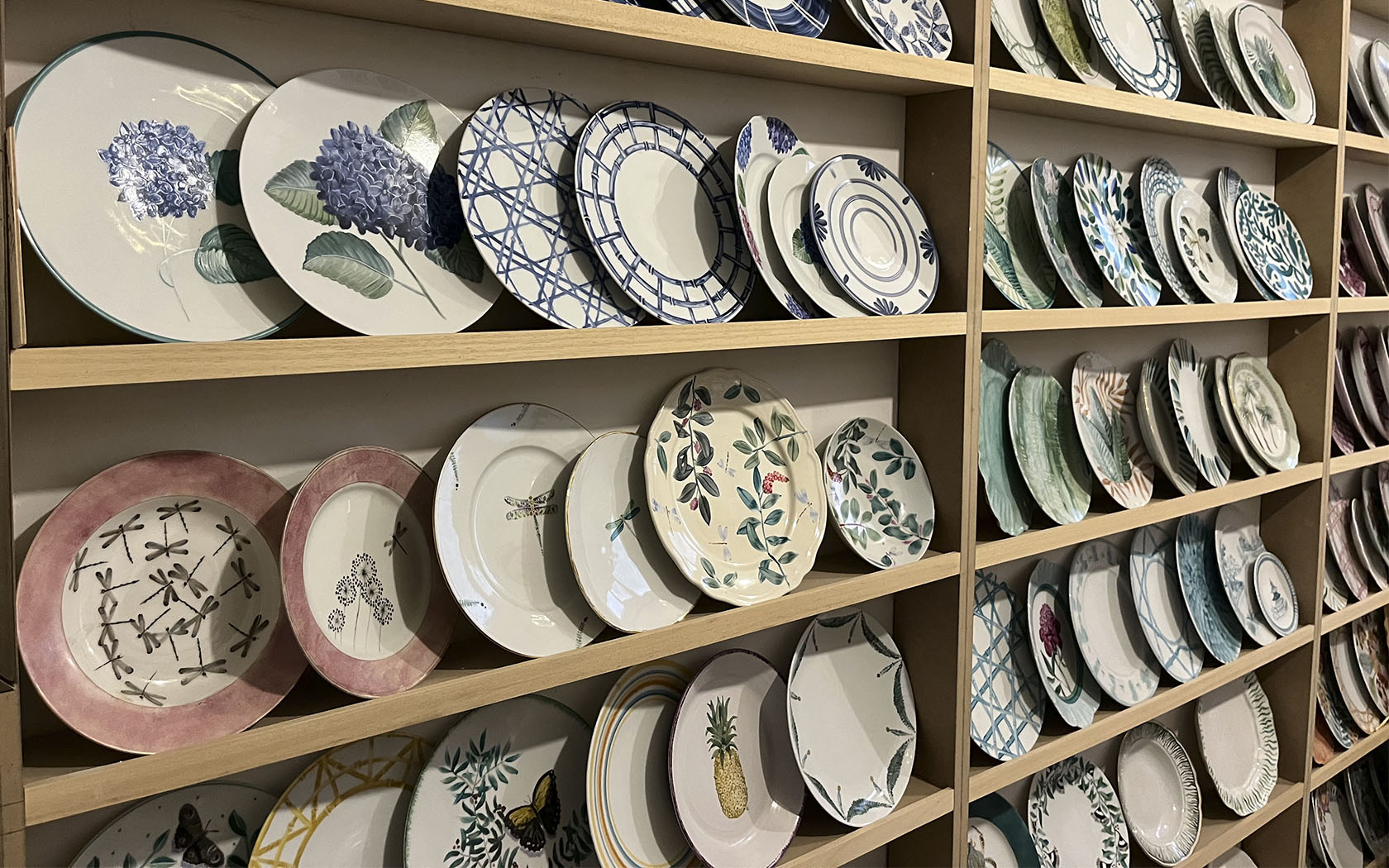She decorates porcelain and creates vibrant tableware compositions for exquisite clients. She loves gardens, and her creative imagination receives constant spurts of nature. Andrea Zarraluqui conveys liveliness, a husky simplicity and a delicacy without cheesiness. She also paints murals, and a couple of years ago she made her debut in wallpaper with Coordonné. She is the artist who has best managed to bring landscape to the plate.
The doors of her studio in Madrid’s Prosperidad neighbourhood, painted blue, already reveal the first traces of a microcosm where the brushes never get bored. An orderly disorder welcomes the visitor, who immediately enters a personal world rich in flora and fauna.

Left: entrance of the studio with a hand-painted door right: interior with the showroom
Stacked earthenware, old porcelain that she will recycle, commissions that she has to send to England or the United States and photographs of gardens from which she wants to extract a certain movement from a leaf accompany the solitude of the craftswoman, who works eight to ten hours a day. “When evening falls, I even sign up for a round of aspirin,” she says with a laugh.

Andrea Zarraluqui showing a painted pocket emptier for the Horse raffle
Her childhood was spent in Jerez de la Frontera, where her parents, Manuel Zarraluqui and Beatriz Pardo Domecq, moved with their five children. They lived in the Croft winery, which her father started, and Andrea remembers those years in the Jerez microclimate with joy: “It was great fun! We used to go to the fair, and, of course, we children quickly learned to dance sevillanas and rumba. I had a half-gipsy aunt, Pepi Román, and when my parents travelled she would take me to the Santiago neighbourhood to listen to flamenco”. She is part of the extensive Domecq lineage, something she is more than proud of: “in the family there are artists, entrepreneurs and disfrutones. As well as being an artist, I could also fit in with the disfrutones”, she says.

When she was young she wanted to study fine arts, but they wouldn’t let her. “It’s not a serious career, my father told me. And we came to an agreement: I would study marketing and communication, and he would allow me to take art courses in the summer”. For years he worked in the communications sector, first in New York, at Vocel Agency, then in Madrid, at Antena 3 and Telefónica, before joining AC Hoteles, where he stayed for seven years, until the merger with Marriott. “They asked me to go to England, but I was too lazy. And it was then that my ex-husband’s mother, to whom I will always be very grateful, suggested to me: you like painting, why don’t you try porcelain,” she recalls.
But Andrea’s life was turned upside down when she was diagnosed with cancer at the age of forty. Six months of chemo, a breast operation, and twenty-five radio sessions. She took refuge in faith and art. “It was a time to stop and think about what I really wanted. What made me tick. And it was always clear to me that it was painting”. And he took the plunge.

Five years have passed, and its tableware is now the favourite of the most demanding and exquisite customers, including celebrities such as Olivia Palermo and Carolina A. Herrera. She declares herself an admirer of Paul Klee, Cy Twombly, the Pre-Raphaelites, Gustav Klimt and José María Sicilia, and she enjoys talking about art almost as much as painting.
Her drawings are born from a careful observation of nature…
Yes, because we often forget to admire the beauty of the world. I like to walk in the countryside, not for exercise, but to see how a leaf moves, or how a mushroom is made. In spring this courtyard is a glory. I love the life of the buds, the blossoming. We live in cities because it’s more convenient for us, but it’s important to go out and see the green…

Designs by Andrea Zarraluqui
His work evokes in me not only William Morris’s celebration of natural exuberance, but also the philosophy of the Arts & Crafts movement: its all-encompassing respect for the figure of the maker and its staunch defence of master craftsmanship.
I am a great admirer of the school of William Morris, of all the artists he gathered around him. Nothing like it has ever been repeated. The Anglo-Saxons have a long tradition both in ceramics and in the love of nature.
I am just as whimsical in my art as I am in my life. I try to bring into my murals, paper or crockery what I miss in a city: plants and animals. And I also plan the combination of the table. I tend to go for green, which is the colour of nature, but suddenly I’m drawn to blue; and now I’ve just finished a crockery inspired by chinoiserie. I get bored of always painting the same thing.
It combines a certain abstraction of nature with the exoticism of tropicalism.
My beginnings were with bananas, yes, but there was a tropical craze and I was too lazy to continue. It happens when something becomes fashionable. Now I’m in a more oriental moment: I’m fixated on bamboo. I’m working on a tableware commissioned by a client who wants me to reproduce the garden of her house in Singapore: she’s leaving there and wants to have a souvenir.
What is the real situation of Spanish craftsmanship?
We have a craft that is being lost: glorious carpenters, blacksmiths, ceramists and potters. I usually order earthenware in Puente del Arzobispo (Toledo) – UNESCO Intangible Heritage of Humanity since 2019 – where the potter who takes care of my plates tells me that there used to be eight master potters with another eight or 10 apprentices under them. Now there are only four.
Why doesn’t the general public appreciate the richness of their work?
Now it is being valued more, but in general people don’t want to pay for it. And either the workshops are in demand or they will end up closing. And, on the other hand, tradition is not being followed: the children of the artisans no longer want to continue with the trade. We lack a school that gives prestige to all these trades, a sort of Saint Martins of craftsmanship. If I won the Euromillions, I would do it.
Do you have a working method that you follow?
I tend to take a lot of photos. You see things in the most unsuspected places, even chips in a wall, or stains; they inspire me. Then I transfer the drawings to porcelain, which is more resistant to knocks despite its apparent delicacy. I have suppliers in Limoges and northern Portugal, as there are hardly any porcelain houses left in Spain. Often one plate leads me to another, because I start to think of combinations, colour games, contrasts, always in search of a stroke of beauty.
After talking to Andrea Zarraluqui, I think of the abandoned gardens that were once aesthetic and sonorous paradises. And that she rescues with her beautiful art. Plants, stones, bamboo, clay, porcelain and paintbrushes join forces to dance out of time, moved only by a yearning for beauty.




